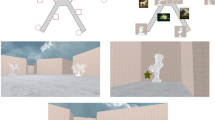Abstract
We examined whether navigation is impacted by experience in two species of nonhuman primates. Five chimpanzees (Pan troglodytes) and seven capuchin monkeys (Cebus apella) navigated a cursor, using a joystick, through two-dimensional mazes presented on a computer monitor. Subjects completed 192 mazes, each one time. Each maze contained one to five choices, and in up to three of these choices, the correct path required moving the cursor away from the Euclidean direction toward the goal. Some subjects completed these mazes in a random order (Random group); others in a fixed order by ascending number of choices and ascending number of turns away from goal (Ordered group). Chimpanzees in both groups performed equivalently, demonstrated fewer errors and a higher rate of self-correcting errors with increasing experience at solving the mazes, and made significantly fewer errors than capuchin monkeys. Capuchins were more sensitive to the mode of presentation than chimpanzees; monkeys in the Ordered group made fewer errors than monkeys in the Random group. However, capuchins’ performance across testing changed little, and they remained particularly susceptible to making errors when the correct path required moving away from the goal. Thus, these two species responded differently to the same spatial challenges and same learning contexts. The findings indicate that chimpanzees have a strong advantage in this task compared to capuchins, no matter how the task is presented. We suggest that differences between the species in the dynamic organization of attention and motor processes contribute to their differences in performance on this task, and predict similar differences in other tasks requiring, as this one does, sustained attention to a dynamic visual display and self-produced movements variably towards and away from a goal.




Similar content being viewed by others
References
Alberts S (1994) Vigilance in young baboons. Effects of habitat, age, sex and maternal rank on glance rate. Anim Behav 47:749–755
Anderson J, Awazu S, Fujita K (2000) Can squirrel monkeys (Saimiri sciureus) learn self-control? A study using food array selection tests and reverse-reward contingency. J Exp Psychol Anim Behav Process 26:87–97
Barkley RA (1997) Behavioral inhibition, sustained attention, and executive functions: constructing a unifying theory of ADHD. Psychol Bull 121:65–94
Bjorklund DF (2004) Children’s thinking. Cognitive development and individual differences. Wadsworth, Belmont
Boesch C, Boesch-Achermann H (2000) The chimpanzees of the Taï Forest: behavioural ecology and evolution. Oxford Univ Press, New York
Case R (1992) The mind’s staircase. Erlbaum, Hillsdale
Case R, Okamoto Y (1996) The role of central conceptual structures in the development of children’s thought. Monogr Soc Res Child Dev 61(1/2):131–155
Cox RFA, Smitsman AW (2006) Action planning in young children’s tool use. Dev Sci 9:628–641
De Kort S, Tebbich S, Dally J, Emery S, Clayton N (2006) The comparative cognition of caching. In: Wasserman E, Zentall T (eds) Comparative cognition: experimental explorations of animal intelligence. Oxford University Press, New York, pp 529–552
De Lillo C, Visalberghi E (1994) Transfer index and mediational learning in tufted capuchins (Cebus apella). Int J Primatol 15:275–287
Diamond A, Kirkham N, Amso D (2002) Conditions under which young children can hold two rules in mind and inhibit a prepotent response. Dev Psychol 38:352–362
Evans TA, Westergaard GC (2006) Self-control and tool-use in tufted capuchin monkeys (Cebus apella). J Comp Psychol 120:163–166
Fagot J, Wasserman E, Young M (2001) Discriminating the relation between relations: the role of entropy in abstract conceptualization by baboons (Papio papio) and humans (Homo sapiens). J Exp Psychol Anim Behav Process 27:316–328
Fischer KW, Bidell T (1998) Dynamic development of psychological structures in action and thought. In: Damon W (series ed), Lerner R (volume ed) Handbook of child psychology: vol 1. Theoretical models of human development (5th edn) John Wiley, New York, pp 467–561
Fragaszy DM, Cummins-Sebree SE (2005) Relational spatial reasoning by a nonhuman: the example of capuchin monkeys. Behav Cogn Neurosci Rev 4:282–306
Fragaszy D, Johnson-Pynn J, Hirsh E, Brakke K (2003) Strategic navigation of two-dimensional alley mazes: comparing capuchin monkeys and chimpanzees. Anim Cogn 6:149–160
Fragaszy D, Crast J, Matsuzawa T (2004a) Intrinsic movements of the hands in chimpanzees and capuchin monkeys. Folia Primatol 75:83
Fragaszy DM, Visalberghi E, Fedigan LM (2004b) The complete capuchin: the biology of the genus Cebus. Cambridge University Press, New York
Genty E, Palmier C, Roeder J (2004) Learning to suppress responses to the larger of two rewards in two species of lemurs, Eulemur fulvus and E macaco. Anim Behav 67:925–932
Hirsch BT (2002) Social monitoring and vigilance behavior in brown capuchin monkeys (Cebus apella). Behav Ecol Sociobiol 52:458–464
Hunt KD (1996) The postural feeding hypothesis: an ecological model for the evolution of bipedalism. S Afr J Sci 92(2):77–90
Iversen I, Matsuzawa T (2001) Acquisition of navigation by chimpanzees (Pan troglodytes) in an automated fingermaze task. Anim Cogn 4:179–192
Johnson-Pynn J, Fragaszy DM, Brakke KE, Hirsh EM, Greenfield PM (1999) Strategies used to combine seriated cups by chimpanzees (Pan troglodytes), bonobos (Pan paniscus), and capuchins (Cebus apella). J Comp Psychol 113:137–148
Kenemans JL, Bekker EM, Lijffijt M, Overtoom CCE, Jonkman LM, Verbaten MN (2005) Attention deficit and impulsivity: selecting, shifting, and stopping. Int J Psychophysiol 58:59–70
Klahr D (1994) Discovering the present by predicting the future. In: Haith MM, Benson JB, Roberts RJ Jr, Pennington BF (eds) The development of future-oriented processes. University of Chicago Press, Chicago, pp 177–218
Kralik JD (2005) Inhibitory control and response selection in problem solving: how cotton-top tamarins (Saguinus oedipus) overcome a bias for selecting the larger quantity of food. J Comp Psychol 119:78–89
Leighty KA, Fragaszy DM (2003) Joystick acquisition in tufted capuchins (Cebus apella). Anim Cogn 6:141–148
Matsuzawa T (2001) Primate foundations of human intelligence: a view of tool use in nonhuman primates and fossil hominids. In: Matsuzawa T (ed) Primate origins of human cognition and behavior. Springer, Tokyo, pp 3–25
McGonigle B, Chalmers M, Dickinson A (2003) Concurrent disjoint and reciprocal classification by Cebus apella in seriation tasks: evidence for hierarchical organization. Anim Cogn 6:185–197
Menzel E Jr, Menzel C (2007) Do primates plan routes? Simple detour problems reconsidered. In: Washburn D (ed) Primate perspectives on behavior and cognition. American Psychological Association, Washington, DC, pp 175–206
Murnane A, Fragaszy D, Hopkins W (2001) Spatial cognition: experience affects how apes navigate two-dimensional mazes. Am J Primatol 54:82
Murray EA, Kralik JD, Wise SP (2005) Learning to inhibit prepotent responses: successful performance by rhesus macaques, Macaca mulatta, on the reversed-contingency task. Anim Behav 69:991–998
Richardson W, Washburn D, Hopkins W, Savage-Rumbaugh E, Rumbaugh D (1990) The NASA/LRC computerized test system. Behav Res Methods Instrum Comput 22:127–131
Rogoff B, Mistry J, Goncu A, Mosier C (1993) Guided participation in cultural activity by toddlers and caregivers. Monogr Soc Res Child Dev 58:R5
Rose L, Fedigan L (1995) Vigilance in white-faced capuchins, Cebus capucinus, in Costa Rica. Anim Behav 49:759–796
Rumbaugh DM, Pate JL (1984) The evolution of cognition in primates: a comparative perspective. In: Roitblat HL, Bever TG, Terrace HS (eds) Animal cognition: proceedings of the Harry N. Frank Guggenheim conference. Lawrence Erlbaum Associates, Hillsdale, New Jersey. pp 569–587
Santos LR, Ericson BN, Hauser MD (1999) Constraints on problem solving and inhibition: object retrieval in cotton-top tamarins (Saguinus oedipus oedipus). J Comp Psychol 113:186–193
Schutte AR, Spencer JR, Schoner G (2003) Testing the dynamic field theory: working memory for locations become more spatially precise over development. Child Dev 74:1393–1417
Scott N, Fragaszy D, Menzel C (2006) Chimpanzees’ (Pan troglodytes) strategies for managing concurrent, asymmetric spatial relations in an insertion task. Am J Primatol 68(Suppl 1):118
Shettleworth S (1998) Cognition, evolution and behavior. Oxford University Press, New York
Siegler R, Alibali M (2004) Children’s thinking, 4th edn. Prentice Hall, Upper Saddle River
Silberberg A, Fujita K (1996) Pointing at smaller food amounts in an analogue of Boysen and Berntson’s (1995) procedure. J Exp Anal Behav 66:143–147
Smith LB, Thelen E (2003) Development as a dynamic system. Trends Cogn Sci 7:343–348
Spencer JR, Hund AM (2003) Developmental continuity in the processes that underlie spatial recall. Cogn Psychol 47:432–480
Spencer JR, Smith LB, Thelen E (2001) Tests of a dynamic systems account of the A-not-B error: the influence of prior experience on the spatial memory abilities of two-year-olds. Child Dev 72:1327–1346
Spinozzi G, De Lillo C, Castelli S (2004a) Detection of grouped and ungrouped parts in visual patterns by tufted capuchin monkeys (Cebus apella) and humans (Homo sapiens). J Comp Psychol 118:297–308
Spinozzi G, Lubrano G, Truppa V (2004b) Categorization of above and below spatial relations by tufted capuchin monkeys (Cebus apella). J Comp Psychol 118:403–412
Thelen E, Smith LB (1994) A dynamic systems approach to the development of cognition and action. MIT Press, Cambridge
Tomasello M, Call J (1997) Primate cognition. Oxford University Press, New York
Treves A (2000) Theory and method in studies of vigilance and aggregation. Anim Behav 60:711–722
van Schaik C, van Noordwijk M (1989) The special role of male Cebus monkeys in predation avoidance and its effect on group composition. Behav Ecol Sociobiol 24:265–276
Visalberghi E, McGrew WC (1997) Cebus meets Pan. Int J Primatol 18:677–681
Willatts P (1989) Development of problem-solving in infancy. In: Slater A, Bremner G (eds) Infant development. Erlbaum, London, pp 143–182
Willatts P (1999) Development of means-end behavior in young infants: pulling a support to retrieve a distant object. Dev Psychol 35:651–667
Wright K (2007) The relationship between locomotor behavior and limb morphology in brown (Cebus apella) and weeper (Cebus olivaceus) capuchins. Am J of Primatol 69:1–21
Wulf G, Shea CH (2002) Principles derived from the study of simple skills do not generalize to complex skill learning. Psychon Bull Rev 9:185–211
Acknowledgments
We thank James Fuller for developing the original maze presentation software, Emil Menzel for development of the pixel tracking program, and the UGA Instrument Shop for the creation of our testing apparatus. We thank Liz Hirsch, Amy Venable, Monique Dase, Jacqueline Montoya, Dayana Atalah, and Katie Leighty for assistance in testing the monkeys, and Carrie Rosengart, Jinae Lee and Jaxx Reeves for aid in statistical analysis. We thank our anonymous reviewers for careful comments which substantially improved this manuscript. This work was supported by HD06016, HD38051, and MH58855 from the National Institutes of Health (USA) and SBR-9729485 from the National Science Foundation to Georgia State University, and the University of Georgia. This study complied with all laws regulating animal care and use in the United States.
Author information
Authors and Affiliations
Corresponding author
Rights and permissions
About this article
Cite this article
Fragaszy, D.M., Kennedy, E., Murnane, A. et al. Navigating two-dimensional mazes: chimpanzees (Pan troglodytes) and capuchins (Cebus apella sp.) profit from experience differently. Anim Cogn 12, 491–504 (2009). https://doi.org/10.1007/s10071-008-0210-z
Received:
Revised:
Accepted:
Published:
Issue Date:
DOI: https://doi.org/10.1007/s10071-008-0210-z




